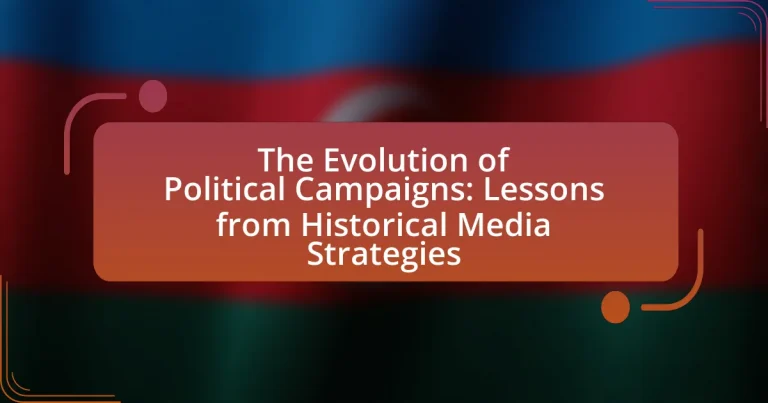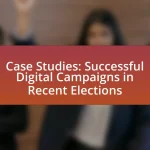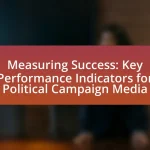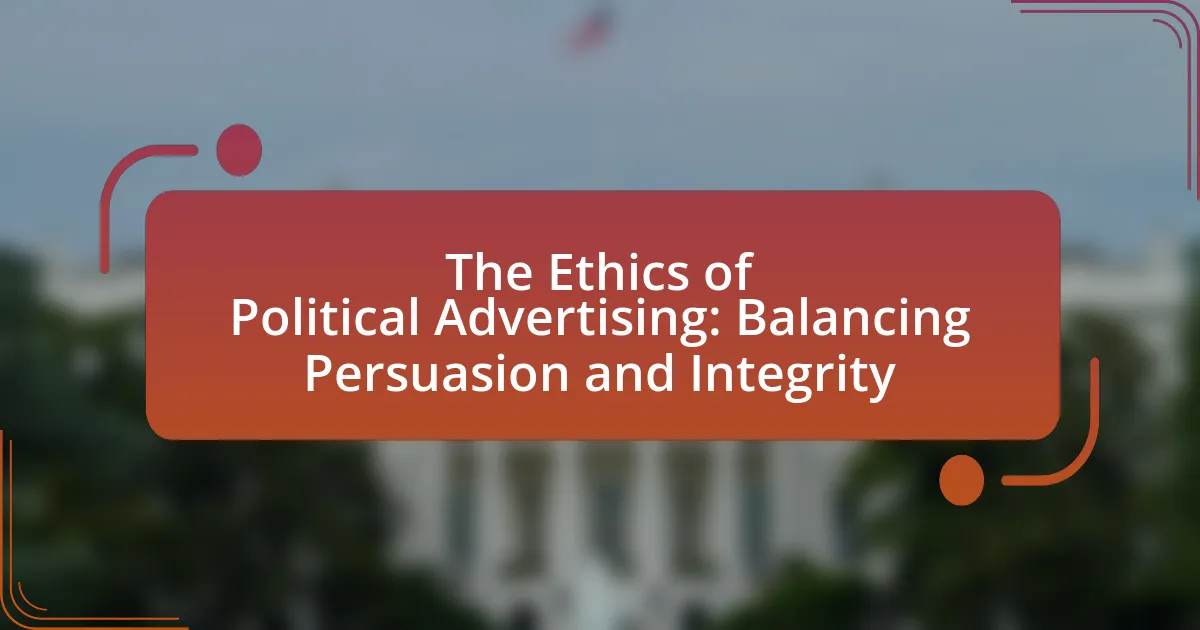The article examines the evolution of political campaigns, highlighting key milestones in media strategies from the introduction of the printing press to the rise of digital platforms. It discusses how early campaigns utilized print media for outreach, the transformative impact of radio and television, and the significant role of the internet and social media in modern campaigning. The article also explores how technological advancements have shaped voter engagement and decision-making, emphasizing the importance of targeted messaging and data analytics. Additionally, it provides insights into best practices derived from historical strategies that can inform contemporary political communication and enhance voter trust and engagement.
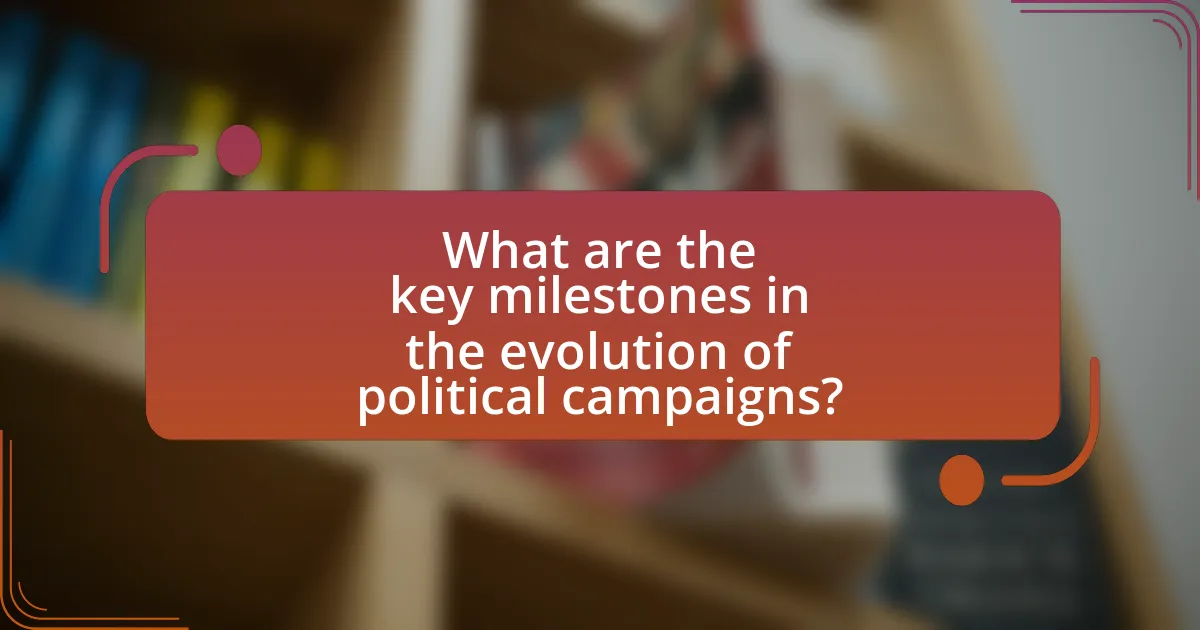
What are the key milestones in the evolution of political campaigns?
The key milestones in the evolution of political campaigns include the introduction of the printing press in the 15th century, which enabled the mass distribution of pamphlets and newspapers, significantly increasing political engagement. The 19th century saw the rise of organized political parties and the use of campaign rallies, exemplified by Andrew Jackson’s 1828 campaign, which emphasized grassroots mobilization. The advent of radio in the 1920s allowed candidates like Franklin D. Roosevelt to connect directly with voters through “fireside chats,” enhancing personal appeal. The television era began in the 1950s, with John F. Kennedy’s 1960 campaign demonstrating the power of televised debates to influence public perception. The emergence of the internet in the late 20th century transformed campaigns through digital advertising and social media, as seen in Barack Obama’s 2008 campaign, which effectively utilized online platforms for outreach and fundraising. Each of these milestones reflects significant shifts in communication technology and strategy, shaping how candidates engage with the electorate.
How did early political campaigns utilize media for outreach?
Early political campaigns utilized media for outreach primarily through printed materials such as pamphlets, newspapers, and posters. These forms of media allowed candidates to disseminate their messages widely, engage with voters, and shape public opinion. For instance, during the 1828 presidential campaign of Andrew Jackson, pamphlets and newspapers played a crucial role in promoting his image as a man of the people, contrasting with his opponent John Quincy Adams. This strategic use of print media helped Jackson secure a significant victory, demonstrating the effectiveness of early media outreach in political campaigns.
What forms of media were prevalent in early political campaigns?
Early political campaigns predominantly utilized print media, particularly newspapers and pamphlets, to disseminate information and influence public opinion. Newspapers served as the primary source of news and political discourse, with candidates often using them to publish their platforms and engage with voters. Pamphlets, which were widely distributed, allowed for more detailed explanations of candidates’ positions and were instrumental in shaping voter perceptions. Historical evidence shows that during the 19th century, the rise of mass printing technology significantly increased the availability of these media forms, facilitating broader access to political information and contributing to the democratization of political engagement.
How did these media forms shape public perception of candidates?
Media forms such as television, radio, and social media significantly shaped public perception of candidates by influencing the way information is disseminated and consumed. Television, for instance, became a pivotal medium during the 1960 presidential debates, where John F. Kennedy’s polished appearance contrasted with Richard Nixon’s less favorable presentation, leading to a shift in public opinion favoring Kennedy. Similarly, radio allowed candidates to connect with voters through direct communication, enhancing relatability and personal appeal. In the digital age, social media platforms enable candidates to engage with voters in real-time, allowing for rapid response to events and direct interaction, which can either bolster or damage a candidate’s image based on public feedback. These media forms have consistently played a crucial role in shaping narratives around candidates, influencing voter perceptions and ultimately election outcomes.
What role did technological advancements play in political campaigning?
Technological advancements have significantly transformed political campaigning by enhancing communication, targeting, and engagement strategies. The introduction of television in the 1960s allowed candidates like John F. Kennedy to reach a broader audience, influencing public perception through visual media. The rise of the internet in the 1990s further revolutionized campaigns, enabling real-time communication and grassroots mobilization, exemplified by Barack Obama’s 2008 campaign, which effectively utilized social media platforms to engage younger voters and raise funds. Data analytics and micro-targeting, made possible by advancements in technology, have allowed campaigns to tailor messages to specific demographics, increasing voter outreach efficiency. These advancements have fundamentally changed how candidates connect with voters, shaping modern political landscapes.
How did the invention of the printing press impact political communication?
The invention of the printing press significantly transformed political communication by enabling the mass production of written materials, which facilitated the widespread dissemination of political ideas and information. This technological advancement allowed for pamphlets, newspapers, and books to reach a broader audience, breaking the monopoly of information held by the elite and the church. For instance, during the Reformation, Martin Luther’s 95 Theses were printed and distributed widely, challenging the Catholic Church and influencing public opinion. The printing press thus democratized access to information, fostering public debate and engagement in political matters, which ultimately contributed to the rise of modern democratic practices.
What changes occurred with the advent of radio and television in campaigns?
The advent of radio and television transformed political campaigns by enabling candidates to reach a broader audience and communicate their messages more effectively. Radio allowed for immediate dissemination of campaign messages, while television added a visual element that enhanced candidate visibility and relatability. For instance, the 1960 presidential debate between John F. Kennedy and Richard Nixon showcased how television could influence public perception, as viewers who watched the debate felt Kennedy performed better, while radio listeners favored Nixon. This shift marked a significant change in campaign strategies, emphasizing the importance of media presence and image management in modern politics.
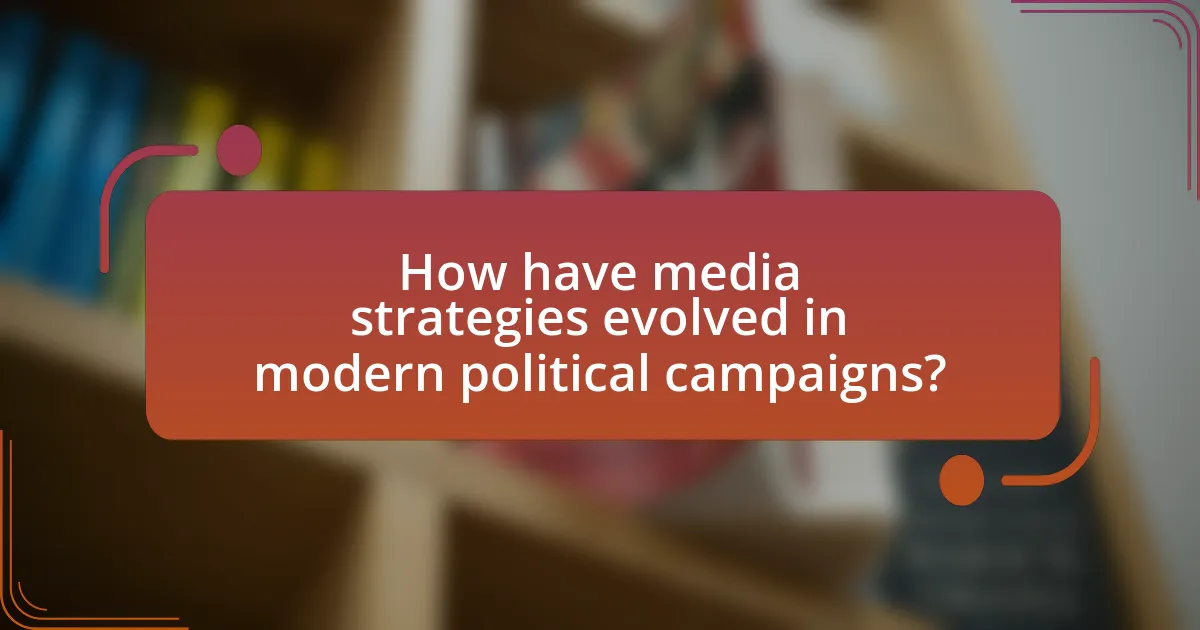
How have media strategies evolved in modern political campaigns?
Media strategies in modern political campaigns have evolved significantly due to advancements in technology and changes in voter behavior. Traditional media, such as television and print, has been supplemented and, in some cases, replaced by digital platforms, including social media and targeted online advertising. For instance, the 2008 Obama campaign effectively utilized social media to engage younger voters, demonstrating a shift towards direct voter interaction and grassroots mobilization. Additionally, data analytics has become crucial, allowing campaigns to tailor messages to specific demographics, as seen in the 2016 election where micro-targeting was extensively employed. This evolution reflects a broader trend of increasing personalization and immediacy in political communication, adapting to the preferences and habits of the electorate.
What are the defining characteristics of contemporary political media strategies?
Contemporary political media strategies are characterized by their reliance on digital platforms, targeted messaging, and real-time engagement with audiences. Digital platforms, such as social media and websites, enable campaigns to reach specific demographics efficiently, allowing for tailored content that resonates with individual voter concerns. Targeted messaging utilizes data analytics to craft personalized communications, enhancing voter connection and mobilization. Real-time engagement fosters immediate interaction, enabling campaigns to respond swiftly to events and public sentiment, which is crucial in a fast-paced information environment. These strategies reflect the shift from traditional media reliance to a more dynamic, interactive approach that leverages technology for effective political communication.
How do social media platforms influence voter engagement today?
Social media platforms significantly influence voter engagement today by facilitating direct communication between candidates and voters, enhancing information dissemination, and fostering community discussions. These platforms allow candidates to share their messages instantly and interactively, which can lead to increased voter awareness and participation. For instance, a study by the Pew Research Center found that 69% of adults in the U.S. use social media, and among those, 50% reported that social media influenced their political views. This direct engagement can mobilize voters, as seen in the 2020 U.S. presidential election, where social media campaigns played a crucial role in driving turnout, particularly among younger demographics.
What role does data analytics play in shaping campaign strategies?
Data analytics plays a crucial role in shaping campaign strategies by enabling political campaigns to make data-driven decisions that enhance targeting and messaging effectiveness. By analyzing voter demographics, preferences, and behaviors, campaigns can tailor their outreach efforts to specific segments, increasing engagement and conversion rates. For instance, the 2008 Obama campaign utilized data analytics to identify key voter groups and optimize resource allocation, resulting in a significant increase in voter turnout. This demonstrates that leveraging data analytics not only informs strategy but also directly impacts campaign success through informed decision-making.
Why is understanding historical media strategies important for current campaigns?
Understanding historical media strategies is crucial for current campaigns because they provide insights into effective communication techniques and audience engagement methods. Historical campaigns, such as Franklin D. Roosevelt’s use of radio or John F. Kennedy’s televised debates, demonstrate how media can shape public perception and influence voter behavior. Analyzing these strategies reveals patterns in voter response and the impact of media evolution on political messaging, allowing current campaigns to tailor their approaches based on proven successes and failures. For instance, the rise of social media has transformed how campaigns interact with constituents, echoing earlier shifts from print to broadcast media. By studying these transitions, modern campaigns can better navigate the complexities of today’s media landscape and enhance their outreach efforts.
What lessons can modern campaigns learn from past media strategies?
Modern campaigns can learn the importance of targeted messaging from past media strategies. Historical campaigns, such as John F. Kennedy’s 1960 presidential campaign, effectively utilized television to reach specific demographics, demonstrating that understanding audience segments enhances engagement. Additionally, the use of storytelling, as seen in Franklin D. Roosevelt’s Fireside Chats, shows that creating a personal connection with voters can foster trust and loyalty. These examples highlight that leveraging media channels and crafting relatable narratives are crucial for resonating with contemporary audiences.
How can historical media strategies inform future political communication?
Historical media strategies can inform future political communication by providing insights into effective messaging, audience engagement, and the impact of media formats. For instance, the use of radio in Franklin D. Roosevelt’s “Fireside Chats” demonstrated how direct communication can build trust and connect with the public, a strategy that remains relevant in today’s digital landscape. Additionally, the televised debates between John F. Kennedy and Richard Nixon in 1960 highlighted the importance of visual presentation and personal charisma, influencing how candidates approach media appearances. These historical examples illustrate that understanding past media strategies can guide contemporary political campaigns in crafting messages that resonate with voters and utilizing media channels effectively.
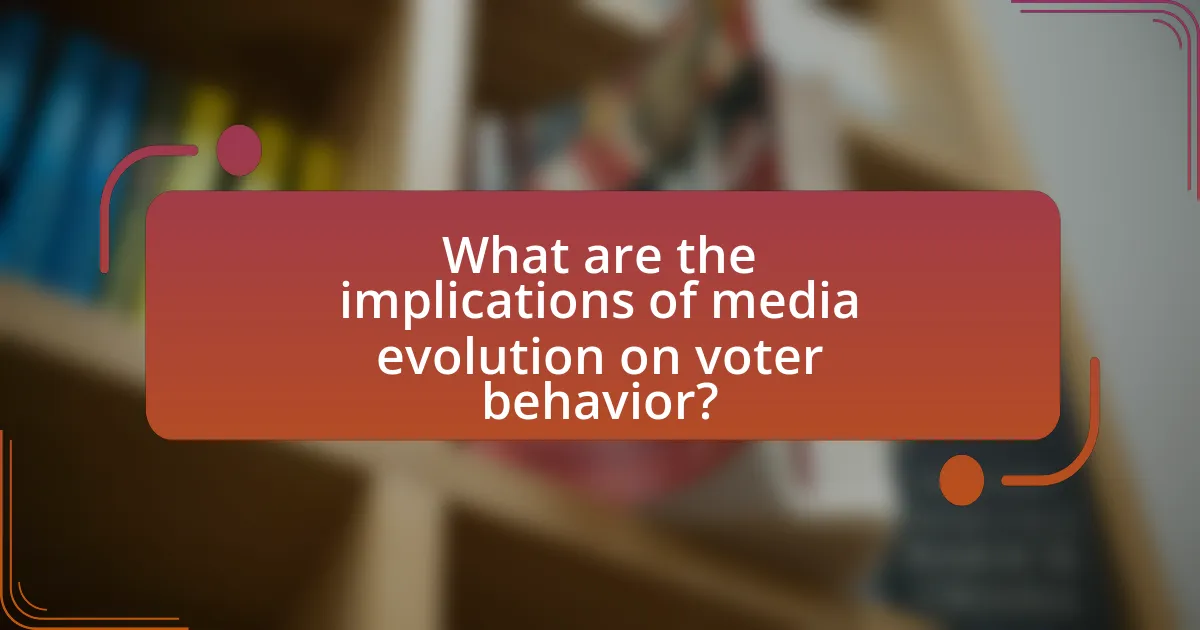
What are the implications of media evolution on voter behavior?
The implications of media evolution on voter behavior include increased access to information, shifts in engagement strategies, and changes in the influence of traditional versus digital media. As media has evolved from print to broadcast to digital platforms, voters have gained unprecedented access to diverse viewpoints and real-time information, which can lead to more informed decision-making. For instance, studies show that social media platforms significantly impact voter mobilization, with a 2018 Pew Research Center report indicating that 69% of adults in the U.S. use social media, influencing their political opinions and engagement. Additionally, the evolution of media has shifted campaign strategies, with candidates increasingly utilizing targeted digital advertising to reach specific demographics, thereby altering voter outreach and engagement methods. This shift highlights the growing importance of online presence in shaping voter perceptions and behaviors.
How has media evolution changed the way voters consume political information?
Media evolution has significantly transformed how voters consume political information by shifting from traditional print and broadcast media to digital platforms. This transition has enabled voters to access real-time news, engage with interactive content, and participate in discussions through social media, which has increased the speed and volume of information available. According to a Pew Research Center study, as of 2021, 53% of U.S. adults reported getting news from social media, highlighting a major shift in consumption habits. Furthermore, the rise of personalized algorithms on platforms like Facebook and Twitter allows voters to receive tailored political content, influencing their perceptions and engagement with political issues. This evolution has led to a more fragmented media landscape, where voters often encounter echo chambers that reinforce their existing beliefs.
What impact does media saturation have on voter decision-making?
Media saturation significantly influences voter decision-making by overwhelming individuals with information, which can lead to confusion and disengagement. Research indicates that when voters are exposed to excessive media content, they may struggle to discern credible information from misinformation, ultimately affecting their ability to make informed choices. A study by the Pew Research Center found that 64% of Americans believe that fabricated news stories cause confusion about the basic facts of current events, illustrating how media saturation can distort perceptions and hinder rational decision-making.
How do different demographics respond to various media strategies?
Different demographics respond to various media strategies based on their unique preferences, values, and consumption habits. For instance, younger audiences, particularly Millennials and Gen Z, tend to engage more with social media platforms like Instagram and TikTok, where visual content and influencer marketing are effective. In contrast, older demographics, such as Baby Boomers, often prefer traditional media like television and print, responding better to direct messaging and established news sources.
Research by the Pew Research Center indicates that 95% of adults aged 18-29 use social media, while only 40% of those aged 65 and older do, highlighting the stark differences in media consumption. Furthermore, studies show that targeted messaging tailored to specific demographic characteristics, such as cultural values and interests, significantly enhances engagement and conversion rates. For example, campaigns that incorporate local cultural references resonate more with specific ethnic groups, leading to higher levels of trust and response.
What best practices can be derived from historical media strategies for future campaigns?
Best practices derived from historical media strategies for future campaigns include targeted messaging, leveraging emerging technologies, and maintaining consistent branding. Targeted messaging, as seen in the 1960 Kennedy-Nixon debates, emphasizes the importance of understanding audience demographics and tailoring communication to resonate with specific voter groups. Leveraging emerging technologies, demonstrated by Obama’s 2008 campaign utilizing social media for grassroots mobilization, shows the effectiveness of engaging voters through platforms they frequent. Consistent branding, exemplified by Reagan’s clear and memorable campaign themes, reinforces a candidate’s identity and values, making it easier for voters to connect with them. These practices are validated by historical successes that highlight their impact on voter engagement and campaign effectiveness.
How can campaigns effectively integrate traditional and digital media?
Campaigns can effectively integrate traditional and digital media by creating a cohesive strategy that leverages the strengths of both platforms. This integration involves using traditional media, such as television and print, to build brand awareness and credibility while utilizing digital media for targeted engagement and real-time feedback. For instance, a campaign can run a television ad that directs viewers to a social media platform for further interaction, thereby bridging the gap between the two mediums. Research indicates that campaigns employing a multi-channel approach can increase voter engagement by up to 30%, demonstrating the effectiveness of combining traditional and digital strategies.
What strategies can enhance voter trust and engagement in political campaigns?
To enhance voter trust and engagement in political campaigns, strategies such as transparent communication, community involvement, and leveraging social media effectively can be employed. Transparent communication builds credibility by providing clear, honest information about policies and campaign goals, which has been shown to increase voter confidence. Community involvement fosters a sense of connection between candidates and constituents, as evidenced by grassroots movements that have successfully mobilized voters through local events and discussions. Additionally, effective use of social media allows campaigns to engage directly with voters, facilitating real-time feedback and interaction, which studies indicate can significantly boost voter participation and trust in the electoral process.
